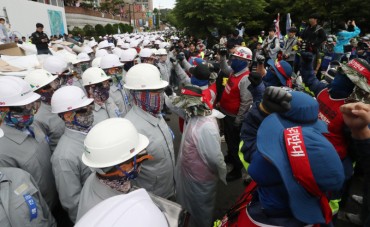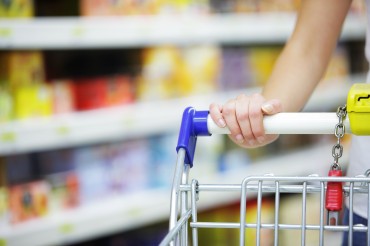
People purchase groceries at a supermarket in Seoul in this file photo taken on Dec. 11, 2022. (Yonhap)
SEOUL, Dec. 16 (Korea Bizwire) — South Korea took advantage of post-pandemic recovery through early 2022, but this year was overall challenging for the export-dependent nation as it felt the pinch of inflation sparked by the Russia-Ukraine war resulting in monetary tightening moves and slowed exports.
Earlier this year, the South Korean government painted a rosy picture of a 3.1 percent growth for Asia’s No. 4 economy, citing post-pandemic normalcy and improved trade.
The finance ministry and the central bank currently estimate this year’s growth to hover around 2.6 percent.
In 2020, the South Korean economy retreated 0.7 percent, bearing the brunt of COVID-19, but it soon expanded by 4.1 percent in the following year, the highest growth rate in 11 years as consumption bounced back from the slump.
While the country is anticipated to extend its recovery momentum through this year, the weaker-than-expected growth came as South Korea, along with other global counterparts, suffered a “triple whammy” of inflation, high interest rates and the strong U.S. dollar.
Consumer prices, a key gauge of inflation, rose 5.9 percent on-year in South Korea in the third quarter, marking a sharp rise from the 5.4 percent increase tallied three months earlier.
In July, prices rose a whopping 6.3 percent, the fastest growth in almost 24 years.
Through November, inflation stayed above 2 percent — the central bank’s inflation target over the medium term — for the 20th straight month.
The inflation was led mainly by soaring energy prices following the Russian-Ukraine war, which dealt a harsh blow to South Korea, which depends heavily on imports for its energy needs.
The prices of electricity, water and gas jumped 15.3 percent on-year in the July-September period. In November, the figure shot up 23.1 percent.
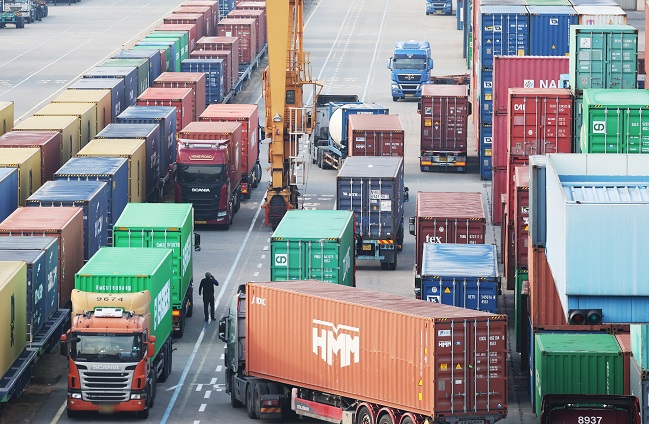
Containers are piled up at a logistics center in Uiwang, south of Seoul, in this file photo taken on Dec. 12, 2022. (Yonhap)
Global economies also suffered inflation. For example, the consumer price index of the United States jumped 9.1 percent on-year in June, the most significant leap in more than 40 years since the 9.6 percent rise tallied in November 1981.
The inflation inevitably led to rate hikes at home and abroad, including in the U.S.
As a result, the South Korean won fell more than 17 percent against the greenback in end-September compared to the first trading session of this year, closing at 1439.9 won per dollar at one point.
The won managed to gather ground later in 2022, closing at 1,306 won on Tuesday — still down 8.7 percent since Jan. 3.
Typically, exporters like South Korea can take advantage of the higher dollar as they receive payments in the greenback.
However, the case was different for 2022, as production costs also shot up due to a rise in import costs, with global consumers scaling down consumption amid fears over a recession.
Accordingly, South Korea suffered a trade deficit for the eighth straight month through November. Exports also fell for the second consecutive month in November due mainly to the dwindling global demand for semiconductors.
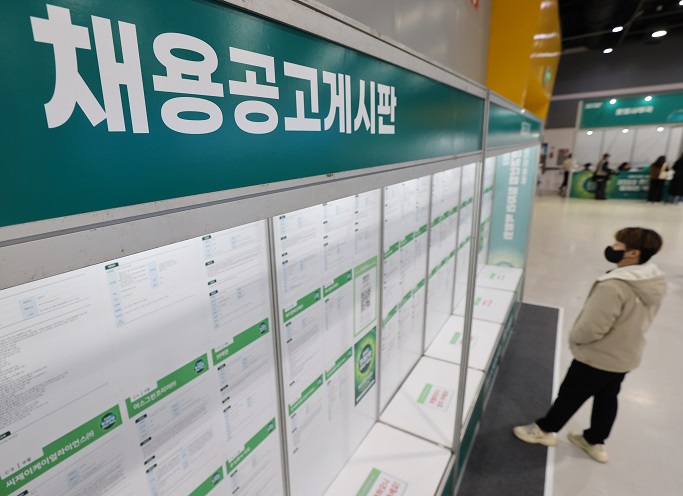
A job seeker reads notices on a bulletin board at a job fair held in Seoul on Nov. 30, 2022. (Yonhap)
While the inflation and the strong U.S. dollar continued to weigh down Asia’s No. 4 economy, the South Korean economy nevertheless managed to avoid a contraction in 2022 on the back of the sound job market and private consumption.
South Korea added jobs for the 21st straight month in November, but the growth continued to slow for the sixth month in a row amid concerns over an economic recession.
Despite the inflation and concerns over a recession, the growth came as new jobs were created in new areas following the COVID-19 pandemic, including contact-free and digital sectors.
“The COVID-19 pandemic has given a significant shock to the face-to-face sectors, but it also accelerated the country’s transition toward the contact-free economy and the fourth industrial sectors, creating new related jobs,” said Kim Ji-yeon, a researcher at the Korea Development Institute (KDI).
The private consumption also rose 5.9 percent on-year in the third quarter on the back of increased spending on services such as accommodation and restaurants.
But experts also fear that private consumption and job creation may lose steam down the road on higher borrowing costs.
In sync with the global central banks’ move to raise borrowing costs, the Bank of Korea has hiked the rate by a combined 2.75 percentage points since August last year, eventually reaching 3.25 percent at the final rate-setting meeting of this year in November.
“We need to consider that all factors of the GDP are facing challenges,” said Kim Young-ick, a professor of economics at the graduate school of Sogang University.
Kim pointed out that the fall in the prices of property, sparked by higher borrowing costs, and the weak securities market will hurt the South Korean economy in 2023 as well.
“As it takes roughly nine to 12 months for a monetary tightening policy to take effect, the economy may rebound in the second half of next year, but we cannot anticipate a sharp recovery,” he added, suggesting the GDP growth may even contract on-year in 2023.
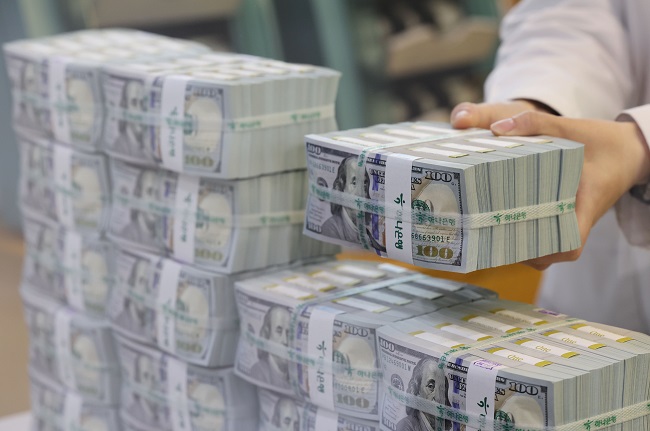
A banker piles U.S. dollar bills at a bank in central Seoul in this file photo taken on Nov. 3, 2022. (Yonhap)
In November, the Bank of Korea lowered its 2023 growth outlook to 1.7 percent from 2.1 percent predicted three months earlier.
Earlier this week, the Asian Development Bank expected the South Korean economy to grow just 1.5 percent, down from the previous estimate of 2.3 percent.
“Due to the eased concerns over the COVID-19 pandemic, South Korea could enjoy a recovery in exports and domestic consumption,” said Kim Jung-sik, an honorary professor of economics at Yonsei University.
“But on the other hand, if the U.S. continues to raise its rates, the move could also adversely impact the exports,” Kim said. “In terms of the local economy, the collapse of the property bubble also poses a threat.”
Experts say the recovery of the economy also depends on external factors.
“Should the situations in Ukraine deteriorate, and the prices of raw materials and grains rise sharply, it will give more inflationary pressure around the globe and weigh down the growth,” the KDI said in its economic outlook report.
“If the U.S. continues to accelerate its rate hike, or if the global economy loses steam significantly, the South Korean economic growth will also slow down,” it added.
Experts are keeping a watchful eye on the recovery of the chip industry as well.
South Korea’s exports of chips, the mainstay product, dipped a whopping 29.8 percent on-year in November, following a 17.4 percent on-year drop tallied a month earlier amid the “down cycle” of the industry.
The trade ministry attributed the decrease to the weak demand of chips and the rising inventory. But the ministry said the sector might gradually recover starting the second half of next year.
Market watchers anticipate the recovery to begin later in 2023.
“Until the first half of 2023, the supply is expected to outpace the demand due to inventories by suppliers at the end of 2022,” Chae Min-sook, a researcher at Korea Investment Co., said.
“But starting the third quarter of 2023, the manufacturers will reduce the production, leading to the balance in the supply and demand starting the fourth quarter,” Chae added.
(Yonhap)



